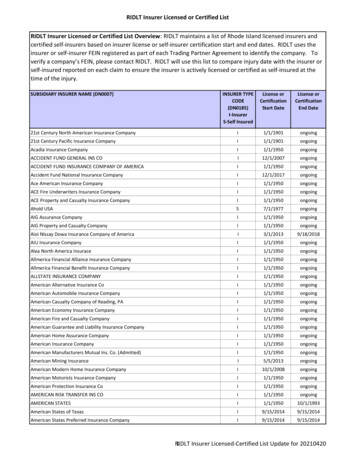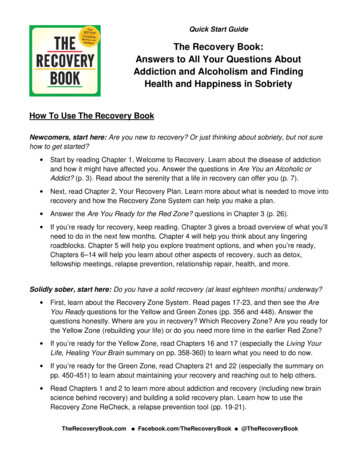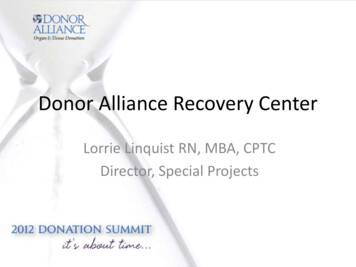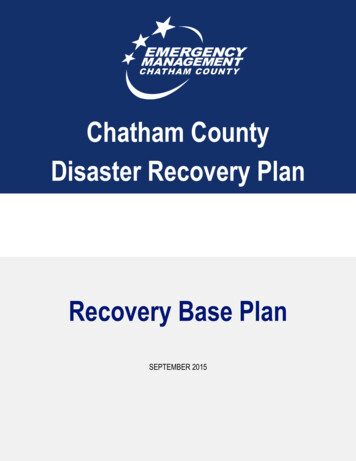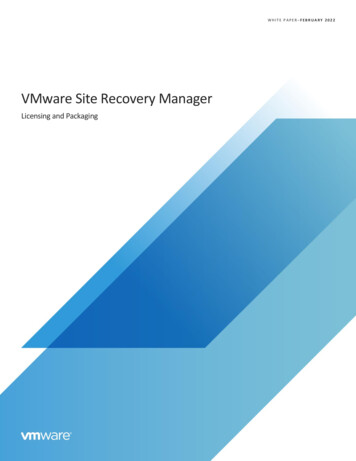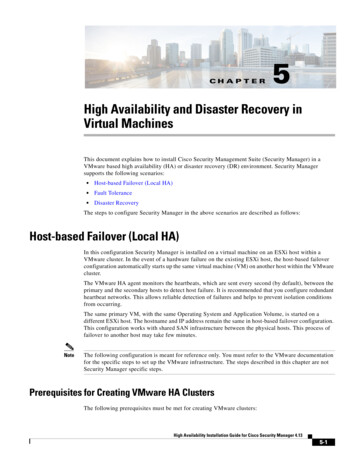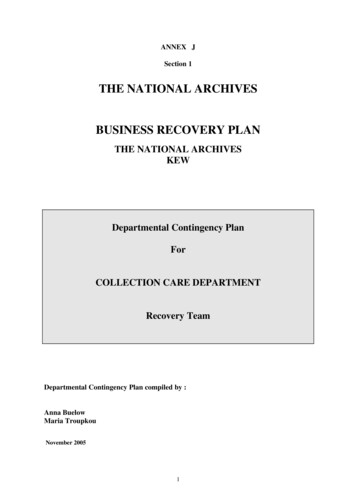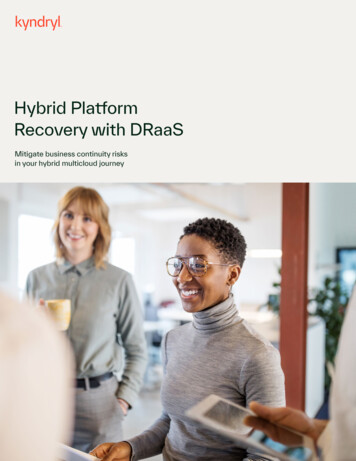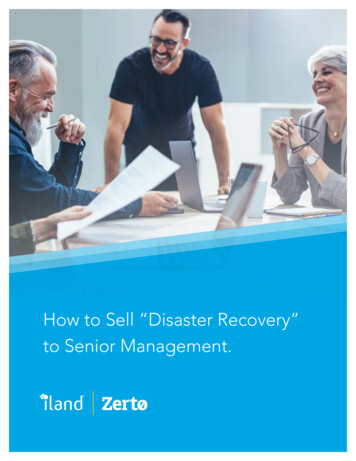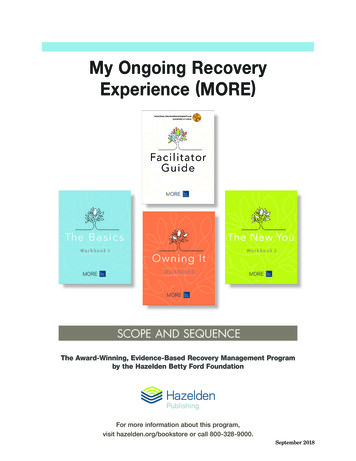
Transcription
My Ongoing RecoveryExperience (MORE)SCOPE AND SEQUENCEThe Award-Winning, Evidence-Based Recovery Management Programby the Hazelden Betty Ford FoundationFor more information about this program,visit hazelden.org/bookstore or call 800-328-9000.September 2018
MOREMORE Program OverviewThis overview describes the MORE (My Ongoing Recovery Experience) program,including program lessons and goals. It describes the evidence-based models andapproach used in the program and shows how MORE addresses the issues participantsface in ongoing recovery. It covers the efficacy of the MORE web program and how ithas been evaluated. Also included in this overview is information on how to use theparticipant workbooks in this MORE program in individual or group settings.About MOREMORE began in 2006 and continues as a web- and phone-based recovery coachingprogram that offers 24/7 support to Hazelden Betty Ford Foundation participants in thecritical first twelve to eighteen months after they leave treatment.MORE was designed to help participants better transition back into a home livingenvironment after being in a highly structured treatment setting. Most addictionrelapses occur within the first eighteen months of recovery, with most happeningwithin the first six months after an individual leaves treatment. Research conducted byHazelden, the leading nonprofit alcohol and drug treatment foundation, suggested that ifindividuals could remain abstinent for at least one year after treatment, they would havea good chance of staying sober for the rest of their lives. This is why in 2006 Hazeldencreated MORE as a health-coaching program to offer 24/7 web- and phone-based supportto participants for a full eighteen months after leaving treatment.Individuals leaving the safety and structure of treatment can use the MORE webprogram to learn essential relapse prevention strategies, how to structure their day,and how to plan for high-risk situations. They can utilize the recovery resources,activities, videos, and articles in the MORE library to learn about addiction and theTwelve Steps, and how to sustain resilience amid the challenges of early recovery. Thiswealth of information helps them manage their new life in recovery and develop theskills necessary to maintain a healthy balance. They also learn how important it is toask for support from counselors, peers, and family members, and to take part in theircommunity, Alcoholics Anonymous, and other peer-support meetings.AccoladesThe MORE program has been a huge success. In 2007, MORE won a silver eHealthcareLeadership Award for Best Care/Disease Management Site. In 2010, Hazelden workedwith the U.S. Navy to create Navy MORE to support service men and women inrecovery. In 2011 Hazelden created the Mobile MORE Field Guide to Life app based onFor more information about this program, visit hazelden.org/bookstore or call 800-328-9000.Copyrighted material. All rights reserved.2 /17
MOREthe foundational education and strategies of the larger web program. That app won theWhite House Behavioral Health Patient Empowerment Challenge award. The MobileMORE Field Guide to Life app also was a 2014 eHealthcare Leadership Award Winnerfor Best Healthcare Content.What Is the Print Version of MORE and How Did It Originate?The print version of the MORE program was designed to translate the core educationand skills from the original web-based MORE program into three print workbooks forclients and a facilitator guide that are more accessible to people in environments wherethe internet is restricted or is not the preferred access point for education. This includestreatment centers and environments where print books are preferred to internet-basedtools or are used in addition to them.This MORE print program does not include access to the MORE web program ormobile application. This program includes the use of three workbooks created to supportadults in early recovery from addiction and co-occurring mental health disorders.These workbooks are an ideal tool to support individuals as they leave treatment andtransition back to independent living in a supportive community.What Is the Evidence-Based Model for MORE?MORE is based on current brain research and several treatment modalities, includingstages of change, motivational enhancement therapy, and cognitive-behavioral therapy.The lessons in this MORE program are designed as part of a recovery managementapproach to help participants develop skills and self-care practices in the importantliving domains necessary to build and sustain an ongoing life in recovery as they workfrom a clinically managed model of care toward self-management of the disease ofaddiction.Because severe and persistent substance use disorders affect many areas of lifefunctioning, programs of recovery must cover multiple domains, including participanteducation, relapse prevention, Twelve Step recovery and spiritual health, family andrelationships, mental health, emotional health, physical health, employment andvocational skills, and life skills. This MORE program offers education in all of thesedomains of recovery.Addiction is a chronic disease that can be controlled but not cured. In this way,addiction is similar to diabetes or high blood pressure, which requires ongoingmanagement because there is not a onetime cure. Addiction treatment provides aFor more information about this program, visit hazelden.org/bookstore or call 800-328-9000.Copyrighted material. All rights reserved.3 /17
MOREstructured environment with support and expertise to help participants stabilize andbuild a solid foundation in recovery. After participants leave the structured environmentof treatment, they need to continue to manage their recovery for a lifetime. A supportedprogram of management for their recovery is often called “recovery management” or“continuing care.” A good recovery management program, such as MORE, will supportparticipants as they work not only to initiate but also to maintain their ongoing recoveryout in the world.ResearchThe Butler Center for Research at the Hazelden Betty Ford Foundation studies outcomesdata for MORE program participants. Data published in 2012 show that individuals whoaccessed a large number of MORE program modules (chapters of content) in the yearfollowing treatment had significantly higher abstinence rates and consumed less alcoholthan individuals accessing few or no modules of content.1 Follow-up research by theButler Center for Research in 2013 reinforced the 2012 findings.2About the Butler Center for ResearchAs the field of addiction treatment increases focus on the importance of patient outcomesand evidence-based practices, the Hazelden Betty Ford Foundation relies on our ownButler Center for Research (BCR) to ensure our treatment programs are data-drivenand proven effective. The BCR began in 1977 to conduct clinical and institutionalresearch to ask the questions that lead to increasingly effective methods of addressingaddiction, from prevention to treatment to lifelong recovery. The goal of this researchand collaborations with other research centers is to not only continuously improve ourclinical services and programs but also to inform the field of addiction and recoveryas a whole. The BCR publishes the latest addiction statistics, a library of articles,and abstracts from our research published in academic journals. Learn more athazeldenbettyford.org/education/bcr.1. A. A. Klein, V. J. Slaymaker, K. L. Dugosh, and J. R. McKay, “Computerized Continuing Care Support for Alcohol andDrug Dependence: A Preliminary Analysis of Usage and Outcomes,” Journal of Substance Abuse Treatment 42, no. 1 (2012):25–34, doi: 10.1016/j.jsat.2011.07.002. Visit https://www.ncbi.nlm.nih.gov/pubmed/21862275 for the abstract.2. A. A. Klein and J. J. Anker, “Computer-Based Recovery Support for Patients Receiving Residential Treatment for Alcohol/Drug Dependence: Relationship Between Program Use and Outcomes,” Telemedicine Journal and e-Health 19, no. 2(2013): 104–9, doi: 10.1089/tmj.2012.0107. Visit https://www.ncbi.nlm.nih.gov/pubmed/23215735 for the abstract.For more information about this program, visit hazelden.org/bookstore or call 800-328-9000.Copyrighted material. All rights reserved.4 /17
MOREWhat Components Are Included in This Program?This MORE program includes a facilitator guide, a video, and three workbooks thatguide participants through increasingly challenging lesson topics as they build theirknowledge and use of effective recovery strategies over time.Facilitator GuideThe facilitator guide offers step-by-step instructions, making it easy to jump into anyMORE lesson and facilitate a great learning experience with participants.Participant WorkbooksThere are three participant workbooks in this program. Workbook 1: The Basicscontains seven lessons. Workbook 2: Owning It contains fifteen lessons, and workbook 3:The New You contains fourteen lessons. Each workbook is approximately 88–120 pagesin length. Most individual lessons can be delivered in one 45- to 60-minute session.Some of the lessons are shorter and easier to complete, and others may stimulate moreparticipant discussion, requiring the full session time to complete. See pages 10–17 for alist of the lessons.Program VideoThe MORE program video includes the following: thirty 1- to 5-minute video segments that feature both experts and real peoplein recovery, which can be used to educate and inspire participants as you teachessential topics two meditation audio files to help participants practice meditation as a grounding,relaxation practiceWho Can Use This Program?This print version of the MORE program can be used by any facilitator working to helpadult participants in early recovery from addiction and co-occurring mental healthdisorders. It can be facilitated by an addiction treatment counselor but is also designedto be easily facilitated by a peer mentor. A peer mentor is also known as a peer leader,peer guide, or peer coach. A peer mentor is a person stable in recovery who acts asa recovery role model to encourage, motivate, and support a peer who is seeking toestablish or strengthen his or her recovery.The workbooks cover very early recovery topics, such as creating a safe livingenvironment, creating a healthy schedule, and learning about the value of peer support.They move toward advanced skills, such as higher-level relapse prevention, improvingFor more information about this program, visit hazelden.org/bookstore or call 800-328-9000.Copyrighted material. All rights reserved.5 /17
MOREspirituality and relationships, and working to address self-defeating beliefs. Thesefoundations of recovery topics are ideal for participants who are in early recoveryand will soon be transitioning from addiction treatment back to their home livingenvironment or a stepped-down level of care, such as outpatient treatment or soberhousing. The workbooks can also be used with people who have been in recovery foryears and who want to revisit or deepen their recovery knowledge and skills.In What Settings Can This Program Be Used?This MORE program may be used in both individual or group settings, although thediscussion possible in group settings will create the best peer-learning experience.The program was designed for use in aftercare or continuing care programs to moveparticipants toward self-management of the disease of addiction. It may be used inaddiction treatment, corrections, or community treatment settings to enhance treatmentreadiness and engagement.Facilitators can use workbook 1: The Basics (seven lessons) as the basis of apsychoeducational continuing care program or also as psychoeducation for a treatmentengagement program. Workbook 2: Owning It (fifteen lessons) and workbook 3: The NewYou (fourteen lessons) can be used to progress participants into more advanced topics orto tailor a session to focus on a topic ideal for participants at any point in time.How Many Weeks Does the Program Take to Complete?The program format is flexible. Facilitators may choose to cover one or two lessonsper week, depending on their program duration. For example, facilitators may chooseto deliver one session per week of workbook 1 to create a seven-week continuing careprogram. Facilitators who want to use MORE to structure a six-month continuing careprogram may choose to use workbooks 1 and 2. Facilitators who want to use MORE tostructure a nine-month continuing care program can cover all three workbooks. See thetable “MORE Session Schedule Options.”For more information about this program, visit hazelden.org/bookstore or call 800-328-9000.Copyrighted material. All rights reserved.6 /17
MOREMORE Session Schedule OptionsPROGRAM DURATIONMORE CONTENTSESSION SCHEDULE7 weeksWorkbook 1: The Basics7 lessons (1 lesson per week)3 monthsWorkbook 1: The Basics22 lessons(2 lessons per week for 11 weeks)(APPROXIMATELY)(12 weeks)ANDWorkbook 2: Owning ItWorkbook 1: The Basics6 months(24 weeks)AND22 lessons(1 lesson per week for 22 weeks)Workbook 2: Owning ItANDWorkbook 1: The Basics9 months(36 weeks)ANDReview of any 2 problem topics in week 12Review of any 2 problem topics in weeks 23 and 2436 lessons (1 lesson per week)ANDWorkbook 2: Owning ItANDWorkbook 3: The New YouWhat Are the Key Topics Covered in the MORE Workbooks?Each of the workbooks covers an area of recovery topics as described below. See pages10–17 for a detailed list of all the lessons included in each workbook.Workbook 1: The BasicsWorkbook 1: The Basics will help your participants build a stable lifestyle to supporttheir recovery. They will learn how to create a safe living environment and how to builda daily schedule that supports their recovery. They will discover that there are somemedications that people in recovery should avoid and learn about safe alternatives.They will learn about the Twelve Steps, the importance of going to meetings, finding asponsor, and how a sponsor can help with recovery. Participants will explore powerlessnessas the foundation of Step One, learn about relapse basics and the warning signs ofrelapse, create a relapse prevention plan, and learn how to deal with a relapse if it doeshappen. They will receive guidance on how to talk about their recovery with friends,family, and coworkers.Workbook 2: Owning ItWorkbook 2 is called Owning It because it helps participants put the skills they arelearning into action in their lives. They will replace old routines with new, healthyhabits that will support their recovery.For more information about this program, visit hazelden.org/bookstore or call 800-328-9000.Copyrighted material. All rights reserved.7 /17
MOREWorkbook 2 digs deeper into foundational recovery skills, such as relapse prevention,utilizing peer support, improving relationships and communication skills, and learningto put the concepts of Steps One and Two into action. This includes accepting the diseaseof addiction and utilizing others’ wisdom and experience in recovery for support.Workbook 3: The New YouWorkbook 3 is called The New You because it helps participants see and continue tocreate positive change in their lives as a result of their work in recovery. Participantsshould start to see real growth and transformation in their life as they continue the corepractices and skills that will sustain them as they manage their ongoing recovery. Thisincludes learning to improve and sustain their motivation to work a strong recoveryprogram; to manage challenging emotions, such as anger and fear; to set boundarieswith others; and to challenge and reframe self-defeating thoughts that could cause themto relapse. They will also learn to deepen their spiritual practice by learning more aboutSteps Two and Three of the Twelve Steps.What Resources Are Included?This MORE program is intended to engage learners of all types: visual learners,auditory learners, those who learn from peers, and those who learn through selfreflection. The workbooks provide a wide variety of resources, including: a Thought for the Day meditation or quote to accompany each topic education and skill-building on important early recovery topics activities that help participants practice self-reflection and put what they arelearning into action “pocket power” Recovery Resources that participants can keep with them forquick reference suggestions for Big Book readings on important topics websites for other recovery resources onlineShould the Workbooks and Lessons Be Completed in Order?There are two methods of choosing MORE workbook lessons to use with participants:progressive or prescriptive.Progressive UseThe three workbooks and associated lessons are designed to be used in sequence in a“progressive” model, starting with workbook 1, lesson 1, and working through each ofthe numbered lessons until eventually ending with the final lesson in workbook 3. ThisFor more information about this program, visit hazelden.org/bookstore or call 800-328-9000.Copyrighted material. All rights reserved.8 /17
MOREprogressive sequence of lessons starts with workbook 1 covering the basics of recovery(e.g., how to create a safe environment, find a sponsor, go to peer-support meetings) andworks through increasingly advanced topics, such as managing triggers and cravings,deepening spirituality, dealing with challenging emotions, improving communicationskills, and combatting addictive thinking and irrational beliefs. This “progressive”method allows you to start with more foundational topics and build gradually into moreadvanced topics as participants learn and grow.Prescriptive UseThough the workbooks and lessons are numbered and are designed to be used in aprogressive sequence, facilitators are not limited to using them in the suggested order.You can select or “prescribe” any individual lesson according to what you need tofocus on with participants at any point in time. If you use the “prescriptive” model ofworking through the workbooks, you may look at the master list of lessons in appendixA of the facilitator guide to find a topic that matches what participants need to focuson during that day’s session. For example, you may find that participants are havingtrouble attending their first Twelve Step meeting, and so you might use workbook 1,lesson 5: Go to Meetings for your next session with those participants. If a participantis struggling with anger issues, you might use workbook 3, lesson 10: Break the AngerCycle. Using the prescriptive model this way is great for tailoring your work withparticipants to cover their immediate challenges in daily living that need to be quicklyaddressed.For more information about this program, visit hazelden.org/bookstore or call 800-328-9000.Copyrighted material. All rights reserved.9 /17
MOREMaster List of Lessons and Learner OutcomesWorkbook 1LESSONSLEARNER OUTCOMESLesson 1:By the end of this lesson, participants will be able to:Create a Safe LivingEnvironment build a safe living environment that supports sobriety understand why they need to “trash their stash” and how toemploy this strategy in their living environment recognize that some medications are not recommended forpeople in recovery and learn to identify safe alternatives understand and explain the importance of abstinence recognize and mitigate the risks of living with others who usealcohol or other drugsLesson 2:By the end of this lesson, participants will be able to:Build a Healthy DailySchedule build a healthy daily schedule that supports recovery describe the benefits of the Twelve Steps and the process ofworking the Steps understand addiction as a disease and how this relates topowerlessness in Step OneLesson 3:By the end of this lesson, participants will be able to:Learn about theTwelve Steps describe the origin of Alcoholics Anonymous (AA) and similarsupport groups and how they work describe the basics of the Twelve Steps of AA and how to workthe Steps understand the spiritual component of the Twelve Steps understand the role of a Higher Power and identify their ownHigher Power describe the twelve promises of AALesson 4:By the end of this lesson, participants will be able to:Step One: UnderstandPowerlessness describe the basics of Step One understand the concept of powerlessness as the foundation ofStep One understand that addiction is a chronic disease that can bemanaged but not cured understand and accept that people with addiction don’t have theability to control or limit their use of alcohol or other drugs liketheir nonaddicted friends explain the process of relapsecontinuedFor more information about this program, visit hazelden.org/bookstore or call 800-328-9000.Copyrighted material. All rights reserved.10 /17
MOREWorkbook 1LESSONSLEARNER OUTCOMESLesson 5:By the end of this lesson, participants will be able to:Go to Meetings understand how to get the most out of Twelve Step groupmeetings, such as AA or NA meetings describe what happens at meetings and how often to attendmeetings understand how to find a meeting identify a local Twelve Step group to attendLesson 6:By the end of this lesson, participants will be able to:Connect with aSponsor describe the importance of having a sponsor in recovery understand what a sponsor does and does not do understand how to choose a sponsorLesson 7:By the end of this lesson, participants will be able to:Create a RelapsePrevention Plan describe the process of relapse and identify relapse warningsigns create a relapse prevention plan identify high-risk situations and develop coping strategies respond to a relapse if it occurs create or update a support list and reach out for helpFor more information about this program, visit hazelden.org/bookstore or call 800-328-9000.Copyrighted material. All rights reserved.11 /17
MOREWorkbook 2LESSONSLEARNER OUTCOMESLesson 1:By the end of this lesson, participants will be able to:Refine Your DailySchedule create a daily schedule to address high-risk situations andmake room for activities that protect recovery understand and use the tips for avoiding risky people, places,and things know the coping strategies to use in a tough situation thatcan’t be avoided understand why it’s important to have a plan to respond to ahigh-risk situation instead of testing themselves by staying in itLesson 2:By the end of this lesson, participants will be able to:Attend a Meeting know how to find a home group understand the benefits of Twelve Step meetings understand and explain the format of Twelve Step meetingsLesson 3:By the end of this lesson, participants will be able to:Cope with Cravings understand the Relapse Trigger Process (trigger, thought,craving, use) be prepared with plans to deal with cravings know how to deal with high-risk situationsLesson 4:By the end of this lesson, participants will be able to:Step One:Understand the Mind understand the concept of powerlessness (Step One) with anemphasis on the mental obsession of addiction understand that abstinence is crucial because the disease ofaddiction leaves people unable to control their use of alcohol orother drugs explain the cycle of addictionLesson 5:By the end of this lesson, participants will be able to:Practice RelapsePrevention Strategies update and improve a daily schedule to avoid high-risk situations use coping strategies to manage high-risk situations that stillcan’t be avoided know when and how to use coping strategies to manage cravingscontinuedFor more information about this program, visit hazelden.org/bookstore or call 800-328-9000.Copyrighted material. All rights reserved.12 /17
MOREWorkbook 2LESSONSLEARNER OUTCOMESLesson 6:By the end of this lesson, participants will be able to:Step One:Understand theSpiritual Connection understand the spiritual component of Step One explain why the addicted person’s defense cannot come fromsimply trying to control his or her use of alcohol or other drugs explain why the addicted person’s defense must come from aHigher PowerLesson 7:By the end of this lesson, participants will be able to:Strive for HOW(Honesty, Openness,and Willingness) explain the importance of honesty, openness, and willingness inrecovery understand the importance of listening with an open mind andsharing openly in recovery understand the importance of personal responsibility in recoveryLesson 8:By the end of this lesson, participants will be able to:Improve Your RelapsePrevention Strategies practice and improve relapse prevention strategies continue identifying and avoiding high-risk situations update and stick to a daily schedule create a list of people they can rely on for supportLesson 9:By the end of this lesson, participants will be able to:Work Step One understand how to work Step One explain the benefits of recovery understand how addiction impacts the mind, body, and spiritLesson 10:By the end of this lesson, participants will be able to:Make Time for Fun explain why it is important to make time for having fun inrecovery understand why it is important to find sober activities identify ways to have sober funLesson 11:By the end of this lesson, participants will be able to:Reflect onRelationships practice performing a relationship inventory utilize strategies to improve relationships with friends, family,and friends from Twelve Step meetings know the importance of spending time with people in therecovery communitycontinuedFor more information about this program, visit hazelden.org/bookstore or call 800-328-9000.Copyrighted material. All rights reserved.13 /17
MOREWorkbook 2LESSONSLEARNER OUTCOMESLesson 12:By the end of this lesson, participants will be able to:Check Your Motivation recognize the importance of staying motivated in recovery distinguish between internal and external sources of motivation apply tips to increase motivationLesson 13:By the end of this lesson, participants will be able to:Work Harder atMeetings get the most out of Twelve Step meetings engage more at meetings by using the suggestions presented evaluate how well they are working their Twelve Step programby completing a checklistLesson 14:By the end of this lesson, participants will be able to:Introduction toStep Two understand the basics of Step Two discover the concept of identifying and surrendering to aHigher Power as the foundation of Step Two recognize the importance of practicing the spiritual componentsof recoveryLesson 15:By the end of this lesson, participants will be able to:Identify and OwnYour Feelings create a daily practice to identify their feelings recognize why it is important to “own” or accept what theyare feeling recognize why monitoring and taking responsibility for feelingsmust be done each dayFor more information about this program, visit hazelden.org/bookstore or call 800-328-9000.Copyrighted material. All rights reserved.14 /17
MOREWorkbook 3LESSONSLEARNER OUTCOMESLesson 1:By the end of this lesson, participants will be able to:Know Your Triggers recognize the importance of following a daily schedule monitor and continue to improve a daily schedule to help managetriggers recognize how a daily schedule can be used to minimize riskysituations use a daily schedule to maximize healthy activities that supportrecoveryLesson 2:By the end of this lesson, participants will be able to:Deepen YourUnderstanding ofStep Two develop a greater understanding of Step Two recognize why spirituality is important in recovery understand what is meant by “restore us to sanity” in Step TwoLesson 3:By the end of this lesson, participants will be able to:Awaken YourSpirituality develop a deeper understanding of spirituality discover what is meant by a “spiritual awakening” in the TwelveSteps apply tips for creating a deeper sense of spirituality in workingthe Twelve StepsLesson 4:By the end of this lesson, participants will be able to:Improve YourSupport System utilize support from a sponsor, healthy friends, family, andpeople in Twelve Step meetings recognize the difference between emotional support,informational support, reflective support, and practical support discover how to use meditation and prayer to support recoveryLesson 5:By the end of this lesson, participants will be able to:Avoid StinkingThinking recognize and avoid addictive thinking patterns, known as“stinking thinking” identify common forms of addictive thinking, such as lip service,grandiosity, rationalization, and injustice apply thought-stopping techniques and strategies to replaceirrational thoughts with accurate thoughtscontinuedFor more information about this program, visit hazelden.org/bookstore or call 800-328-9000.Copyrighted material. All rights reserved.15 /17
MOREWorkbook 3LESSONSLEARNER OUTCOMESLesson 6:By the end of this lesson, participants will be able to:Build Serenity create serenity and spirituality in daily life employ strategies for letting go of controlling behaviors,practicing acceptance, and practicing meditation and prayer recognize the importance of serenity and spirituality in recoveryLesson 7:By the end of this lesson, participants will be able to:Handle EmotionsUsing the ABCDTechnique use strategies to cope with challenging emotions to help avoidrelapse apply the ABCD (Action, Belief, Consequences, Dispute)technique to dispute inaccurate beliefs recognize the importance of disputing inaccurate beliefs inmaintaining recoveryLesson 8:By the end of this lesson, participants will be able to:Practice Refusal Skills identify things that could harm recovery recognize the importance of being prepared to say no in difficultsituations, including with family and friends practice positive refusal skillsLesson 9:By the end of this lesson, participants will be able to:Change Your Thinking understand the nature of irrational, self-defeating beliefs andhow they impact recovery practice strate
There are three participant workbooks in this program. Workbook 1: The Basics contains seven lessons. Workbook 2: Owning It contains fifteen lessons, and workbook 3: The New You contains fourteen lessons. Each workbook is approximately 88-120 pages in length. Most individual lessons can be delivered in one 45- to 60-minute session.
